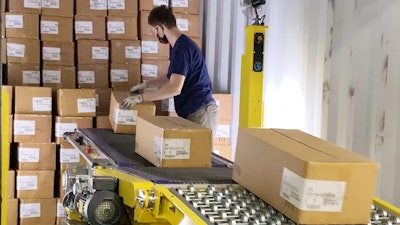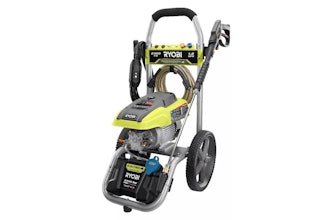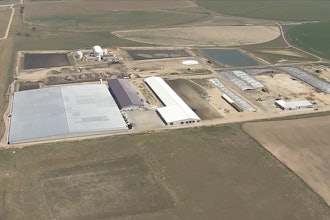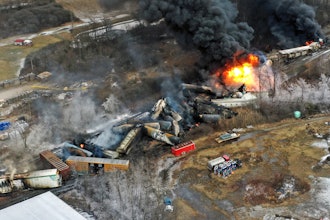
Innovations in Material Handling: Working Smarter, Not Harder
Manufacturing facilities and distribution centers traditionally had to choose between keeping their works safe or keeping them productive. Thanks to recent material handling innovations, companies no longer have to make that trade off.
Innovative and affordable material handling solutions empower workers to perform tasks faster and with more precision, while also reducing the risks of injuries from accidents and repetitive motion and lowering the costs associated with damaged parts, products and machinery.
The combination of increased productivity, less injuries and fewer damaged parts and machines directly increases profit margins.
The Push for Higher Productivity
High productivity has always been crucial to being profitable and remaining competitive and it has become even more important during this period of acute labor shortages in the manufacturing and logistics sectors of the economy.
In fact, the National Association of Manufacturers Outlook Survey found that “attracting and retaining a quality workforce” is one of the top business challenges among respondents and predicts that U.S. manufacturing will have 2.1 million unfilled jobs by 2030.
Instawork reports that 73% of warehouse operators can’t find enough labor.
As companies struggle to recruit and retain workers, the reduced workforce is pressed to be more and more productive. The potential problems with this trend are obvious. “Beyond causing stress, the lack of skilled workers has heightened workplace injury, product liability and property damage risk for these businesses,” warned Liberty Mutual Insurance.
 Gorbel® Inc.
Gorbel® Inc.
Accelerating Trend to Automate
Businesses have increasingly turned to automation to address these challenges. Automation can reduce labor requirements, with fewer employees needed to perform the same functions and it can also help with recruitment and retention by making jobs more appealing to workers.
However, full automation is not appropriate or even possible, for every task and it often does not make business sense. Automation systems are expensive to design, fabricate and install and often require specialized skills to operate and maintain.
For many manufacturing and logistics applications, highly automated systems, including robotics, are simply not suitable because they are less flexible than humans, the most versatile machine of all.
Worker Assistance Solutions
Fortunately, a number of material handling solutions exist between fully manual processes at one end of the spectrum and completely robotic automation systems at the other end.
These solutions utilize innovative system designs and proven technology to assist workers in performing their jobs better and faster, while also reducing strain and injuries and limiting damage to parts and equipment.
These worker assistance solutions combine:
- The strength and power of a machine.
- The control and cognitive thinking of a human.
The basic concepts of mechanical advantage have been known for thousands of years. Understanding the power of the lever and fulcrum, Archimedes is said to have playfully boasted, “give me a place to stand and I will move the world.”
Wheels, pulleys, wedges, screws and other simple machines were put to use to dramatically expand what people could accomplish with much less effort.
 Gorbel® Inc.
Gorbel® Inc.
Intelligent Lift Assist Solutions: Work Smarter, not Harder
Today, material-handling-assistance solutions fulfill the same basic promise, empowering operators to naturally and almost effortlessly lift and maneuver heavy, large and unwieldy objects, as if the devices were an extension of their arms.
Intelligent Lift Assist Devices (ILD) incorporate advanced technology, such as hoist systems with processor-controlled servo drives, to replace back breaking work with fingertip control and maneuverability. But intelligent material handling solutions are not just about advanced technology.
They consist of the smart overall design of complete solutions that utilize cranes and conveyors to best assist workers in each particular material-handling application on the shop floor and at the loading dock.
Intelligent Devices
The Gorbel G-Force Intelligent Lifting Device exemplifies how state-of-the-art technology can effectively enable ergonomic and user-friendly load manipulation. The industrial processor controlled servo drive system allows the G-Force to deliver both unmatched lifting precision and speed, a combination that traditional lifting devices have been unable to offer.
In a study conducted by the Rochester Institute of Technology, workers in high-cycle settings were nearly 70% more productive using this system, compared to other lifting solutions, including manual lifting, chain hoists and air balancers.
The G-Force also excels at giving operators the precise control they need to carefully finesse expensive or fragile parts into place. During precision placement tests, the RIT study found that operators were 77% more efficient than with air balancers and 59% more efficient than with traditional hoists.
The high-speed servo control system and sensor technology, along with the highly-usable design, make the system remarkably easy, effortless and natural to operate. Optional force sensing handles automatically detect force applied without requiring any handle motion, unlike other hoist systems that require operators to press a button or squeeze a handle to initiate upward or downward motion.
Float Mode enables operators to precisely orient loads throughout the full stroke range by manipulating the load with their hands and applying as little as 1/2lb (227 g) of force on the load itself to activate the vertical movement.
A combined collector/air swivel allows the handle to continuously rotate without damaging electrical conductors in the coil cord or optional air coil. This is ideal in applications where the operator is continuously rotating the handle.
The control handles have operator-present sensing functionality, making them safe and intuitive, without the operator needing to depress a physical lever.
Smart System Design of Workstation Cranes
An optimal material-handling solution pairs the intelligent lifting device with a crane system that makes horizontal movement as easy and efficient as the vertical lifting. Workstation cranes achieve this goal better than alternative solutions, with superior maneuverability, enhanced safety and large rectangular area of unobstructed coverage.
Workstation cranes, also called overhead traveling cranes and bridge cranes, are a type of overhead industrial crane that consist of a moving bridge that runs across parallel runways.
A lifting device travels back and forth across the bridge, while movement of the bridge enables simultaneous movement in a perpendicular direction.
A well designed system will offer little rolling resistance of the bridge and trolleys so that operators can move freely around their work cell and perform their tasks in an ergonomic manner.
A workstation crane with an intelligent lifting device is much less complex and expensive than a fully automated system, but still provides vast improvements in productivity and safety compared to forklifts and other traditional material handling methods.
The workstation crane is much more efficient, often dramatically reducing cycle times and freeing up the forklift and the forklift operator to perform other tasks.
Pair that work station crane with an intelligent lifting device instead of a traditional lifting device and you have even more precise control, thereby significantly reducing risk of injuring workers and damaging the product and or the production equipment, like expensive CNC machine chucks
Assisting Workers and Augmenting Robotic Systems
As we noted earlier, material-handling assistance systems provide productivity and safety solutions that fill a gap between fully manual processes at one end of the spectrum and completely robotic automation systems at the other end.
This is often true in the literal sense, in applications where intelligent lifting devices are physically located in front of highly automated systems. In the aerospace industry, for example, it is common to employ ILDs on workstation cranes to load expensive, fragile parts, which can be large and difficult to maneuver, into fixtures in robotic machine centers.
The material-handling assistance systems precisely and safely load and unload the parts, protecting the workers, the parts and the machining equipment.
 Gorbel® Inc.
Gorbel® Inc.
Smart System Design at the Loading Dock
Marrying productivity and safety without complete automation isn’t just for the production floor. There are also material handling innovations at the dock doors that are saving companies time and money.
Another good example of system design that allows workers to work smarter, not harder is Gorbel’s Destuff-it Portable Ergonomic Conveyor Systems. These systems enable workers to more efficiently load and unload containers and trailers, transferring floor-based boxes to the dock area for sorting and palletizing.
The systems provide a safe platform that elevates to position the worker at the optimal height on the box wall, replacing the traditional step ladder and the temptation to stand on boxes. From the platform, the workers transfer items to a conveyor when unloading a container or from a conveyor when loading a container.
A single worker is typically able to achieve a case rate in excess of 800 boxes per hour, depending on the size and weight of the box, cutting unload labor costs by half.
By reducing the amount of lifting, twisting, carrying and overhead reaching required, workers experienced less fatigue and muscle strain. Moreover, the product, which may range from wine bottles to furniture, is less likely to be damaged.
Higher Productivity while Protecting Workers
From the dock door to the production floor, there are a wide range of affordable material handling innovations that can significantly increase productivity and therefore profitability, while also enhancing employee safety and protecting product and equipment.























